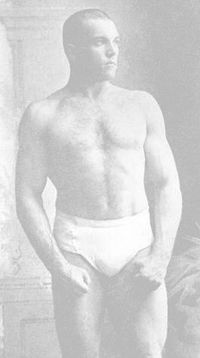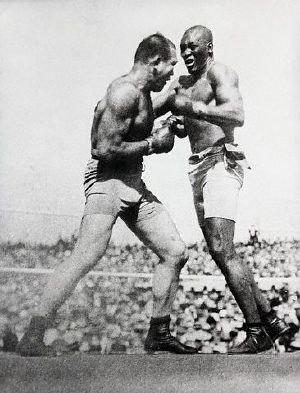James J. Jeffries
| James J. Jeffries | |
 | |
| Statistics | |
|---|---|
| Real name | James Jackson Jeffries |
| Nickname | The Boilermaker |
| Rated at | Heavyweight |
| Nationality | US American |
| Birth date | April 15, 1875 |
| Birth place | Carroll, Ohio, USA |
| Death date | March 3, 1953 |
| Death place | Burbank, California, USA |
| Stance | Orthodox |
| Boxing record | |
| Total fights | 21 |
| Wins | 18 |
| Wins by KO | 14 |
| Losses | 1 |
| Draws | 2 |
| No contests | 0 |
James Jackson Jeffries (April 15, 1875 – March 3, 1953) was world heavyweight boxing champion, from 1899-1905.
Nicknamed "The Boilermaker",
Biography
Youth
In 1891, his father moved his family from their Ohio farm to Los Angeles, California where the powerfully built and athletic teenager boxed as an amateur until age 20 when he started fighting professionally, going undefeated. On his way to the title, Jeffries knocked out Peter Jackson, the great black fighter whom John L. Sullivan had refused to fight, in three rounds. On June 9, 1899 in Brooklyn, New York he defeated Bob Fitzsimmons to win the Heavyweight championship of the world. That August, he embarked on a tour of Europe putting on exhibition fights for the fans. Jeffries was involved in several motion pictures recreating portions of his championship fights. Parts of his other bouts and films of some of his exhibition matches survive to this day.
Physical assets
Jeffries stood six foot, three inches tall and weighed 225 pounds in his prime. Despite his size, Jeffries, who was not a trained runner, could run the 100 yards in a little more than ten seconds, not far off the world-record pace for that era. While working as a sparring partner for James J. Corbett, Jeffries consistently outsprinted Corbett. Corbett was an outstanding, all-around athlete and had never lost a footrace to any of his campmates. Jeffries was also nimble, and could purportedly high-jump over six feet.
His greatest assets were his enormous strength and stamina. Using a technique taught to him by his trainer, former welterweight and middleweight champion Tommy Ryan, Jeffries fought out of a crouch with his left arm extended forward. He was able to absorb tremendous punishment while wearing his opponents down. A natural left-hander, he possessed one-punch knockout power in his left hook.
Becoming champion
Jeffries' manager, William A. Brady, who was able to sign his man for a match with the world heavyweight champion, Bob Fitzsimmons, at the Coney Island Athletic Club. Jeffries embarked on an arduous training regimen for this bout. With the help of middleweight Tommy Ryan he devised a new fighting style which he intended to try out against the lanky Fitzsimmons. Jeffries fought in a crouch with his left arm extended and his face protected by his right forearm. He developed a terrific left hook, as well as a straight left he could throw out of the crouch, often at short range and with great effect.
In the championship bout, Jeffries knocked Fitzsimmons down in the second round. Early in the fight, Fitzsimmons landed some hard punches, but Jeffries's blows were more effective. In the tenth, Jeffries knocked the champion down twice with powerful lefts. In the eleventh, Jeffries finished off Fitzsimmons with a left hook and a right uppercut. The new champion then won a very tough 25-round decision over Tom Sharkey before facing the former champion James J. Corbett. Jeffries had previously served as Corbett's sparring partner and welcomed the chance to best him in the ring. Corbett had the advantage in the first ten rounds and, after twenty rounds, still had a clear lead. But in the twenty-third, Jeffries knocked Corbett out with a straight left and then a left hook to the jaw.
Jeffries defended his title four more times with four knockout victories before retiring. Included among his victims were Fitzsimmons, Corbett, and Gus Ruhlin.
An example of Jeffries' ability to absorb punishment and recover from a severe battering to win a bout can be seen in his rematch for the title with Fitzsimmons, who is regarded as one of the hardest punchers in boxing history. After losing his crown to Jeffries, Fitzsimmons fought and knocked out Jim Daly, Ed Dunkhorst, Ruhlin, and Sharkey. This earned him a rematch with Jeffries, which occurred on July 25, 1902 in San Francisco. For this fight, Jeffries each day would have to run 14 miles, two hours of skipping, medicine-ball training, 20 minutes on the heavy bag, and at least 12 rounds of sparring. He also trained in wrestling.
For nearly eight rounds Fitzsimmons subjected Jeffries to a vicious and merciless battering. Jeffries suffered a broken nose, both his cheeks were cut to the bone, and gashes were opened over both eyes. It appeared that the fight would have to be stopped, as blood freely flowed into Jeffries' eyes. Then in the eighth round, Jeffries lashed out with a terrific right to the stomach, followed by a lethal left hook to the jaw which knocked Fitzsimmons unconscious.
Jeffries has the record for the quickest KO in a heavyweight title fight ever, which was 55 seconds against Finnegan. During his reign as champion, Jeffries defended his title seven times, including two knockout victories over former champion Corbett. He won a 25-round decision over Tom Sharkey. Jeffries broke the ribs of three opponents in title fights: Jim Corbett, Gus Ruhlin, and Tom Sharkey. Jeffries retired undefeated in May of 1905. He served as a referee for the next few years, including the bout in which Marvin Hart defeated Jack Root to stake a claim at Jeffries' vacated 'title.'
Comeback
Six years after retiring, Jeffries made a comeback on July 4, 1910 at Reno, Nevada. He fought champion Jack Johnson, who had staked his claim to the heavyweight championship by defeating Tommy Burns at Rushcutters Bay in Australia in 1908.
Although Jeffries hadn't fought in six years—he was 35 years old and had ballooned to over 315 pounds—he let himself be persuaded to accept the match. After his six-year layoff, the out-of- shape Jeffries had to lose close to 100 pounds, and he had no warmup fights to determine if he could still fight at all.
The fight soon became a symbolic battleground for the races. The media, eager for a "Great White Hope," found a champion for their racism and bigotry in Jeffries. He said, "I am going into this fight for the sole purpose of proving that a white man is better than a Negro."[1] A furor was created at the fight, as a ringside band played, "All coons look alike to me" and promoters encouraged an all-white crowd to chant "Kill the nigger"[2].
Jeffries' belief in his own white superiority was quite literally destroyed, as he was almost knocked out in the fifteenth round. The fight against Johnson was stopped in the fifteenth round, as Jeffries' corner would not allow him to get knocked out by Johnson. Although not a big puncher by heavyweight championship standards, Johnson proved a stronger adversary. This was not the same Jeffries who had reigned as champion. Jeffries was unable to bull Johnson around, as he had every other ring opponent he faced. Jeffries, who had been known for his seemingly superhuman stamina, faded under the midday Reno heat. Aside from a few flashes of the Jeffries of old, the results of the fight were never in doubt.
Jeffries made no excuses at the time. However, later in his biography he implied that he had been drugged prior to meeting Johnson. Johnson, in his own biography, named Jeffries as the greatest heavyweight of all time.
In his later years, Jeffries trained boxers and worked as a fight promoter. He promoted many fights out of a structure known as "Jeffries Barn." Jeffries Barn is now part of Knott's Berry Farm, a Southern California amusement park. On his passing in 1953, he was interred in the Inglewood Park Cemetery in Inglewood, California.
Legacy
Playing the role of the "Great White Hope" in a brutal, 1910 bout with African-American fighter Jack Johnson, Jeffries' belief in his own white superiority was quite literally destroyed, as he was almost knocked out in the fifteenth round. In this racially charged, symbolic battleground for the races, white supremicists found Jeffries a willing champion for their bigotry. However, the fight against Johnson was stopped in the fifteenth round, as Jeffries' corner would not allow him to get knocked out by the object of their hate. Johnson, who was not a big puncher by heavyweight championship standards, proved a stronger and smarter adversary. Jeffries quickly realized he had made a big mistake, and to this day, his bout with Jackson is remembered as a great equalizer in race relations in professional sports. The so-called "Fight of the Century" is immortalized in Howard Sackler's book, The Great White Hope, and a film based on it.
- Inducted into the Ring Boxing Hall of Fame, in 1954
- Inducted into the World Boxing Hall of Fame, 1980.
- Inducted into to the International Boxing Hall of Fame, in 1990.
- Career record: 18 wins (15 KO's), 1 loss, 2 draws.
- Nat Fleischer ranked Jeffries as the #2 All-Time Heavyweight; Charley Rose ranked him as the #5 All-Time Heavyweight.
Footnotes
- ↑ Remnick, David "Struggle for his soul," The Observer, 2003-11-02. Retrieved on November_02, 2003
- ↑ Zinn, Dave "The Hidden History of Muhammad Ali," Edge of Sports
ReferencesISBN links support NWE through referral fees
- Fox, R.K. The Life and Battles of Jack Johnson, Richard K. Fox Publ. Co., 1912. B00088YXPC
- Great White Hope (VHS), 20th Century Fox, 1998. ASIN 6301720385
- Unforgivable Blackness-The Rise and Fall of Jack Johnson (DVD), Pbs Paramount, 2005. B0006FO8IY
- Kent, Graeme. The Great White Hopes: The Quest to Defeat Jack Johnson, Sutton Publishing, 2007. ISBN 978-0750946131
- Sackler, Howard. The Great White Hope, The Dial Press, 1968. ASIN B000MULYDO
External links
Credits
New World Encyclopedia writers and editors rewrote and completed the Wikipedia article in accordance with New World Encyclopedia standards. This article abides by terms of the Creative Commons CC-by-sa 3.0 License (CC-by-sa), which may be used and disseminated with proper attribution. Credit is due under the terms of this license that can reference both the New World Encyclopedia contributors and the selfless volunteer contributors of the Wikimedia Foundation. To cite this article click here for a list of acceptable citing formats.The history of earlier contributions by wikipedians is accessible to researchers here:
The history of this article since it was imported to New World Encyclopedia:
Note: Some restrictions may apply to use of individual images which are separately licensed.
